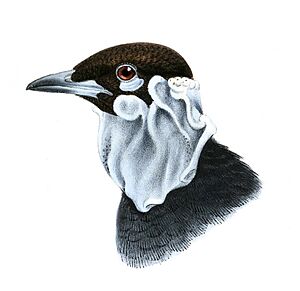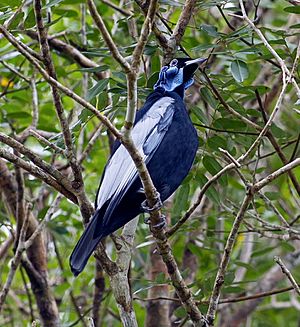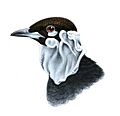Bare-necked fruitcrow facts for kids
Quick facts for kids Bare-necked fruitcrow |
|
|---|---|
 |
|
| Drawing by John Keulemans 1901 | |
 |
|
| Conservation status | |
| Scientific classification | |
| Genus: |
Gymnoderus
|
| Species: |
foetidus
|
 |
|
| Synonyms | |
|
|
The bare-necked fruitcrow (Gymnoderus foetidus) is a unique bird that lives in the Amazon Rainforest. It belongs to the Cotingidae family, which includes many colorful birds. This bird is the only species in its genus, Gymnoderus. This means it's the only one of its kind in that group!
You can find these birds mostly near rivers in the Amazon. They are quite common, but you might see fewer of them north of the Amazon River. Both male and female bare-necked fruitcrows are mostly black. However, the male bird has special features: large, greyish-blue skin patches on its face and neck, called wattles. Its wings are also greyish-white, which really stand out when it flies!
Contents
About the Bare-necked Fruitcrow
The bare-necked fruitcrow is a medium-sized bird. It has a strong body and a short tail. Its most striking feature is the bare skin on its head and neck. This skin can look wrinkled and is often a dull blue or grey color.
These birds are usually quiet. They spend a lot of time sitting still in the trees. They often perch high up, watching their surroundings. Their diet mainly consists of fruits. They play an important role in the rainforest by spreading seeds from the fruits they eat.
Where Bare-necked Fruitcrows Live
Bare-necked fruitcrows live in the vast Amazon Rainforest. This huge forest covers parts of several South American countries. They prefer areas close to water, like rivers and streams. This habitat provides them with plenty of food and shelter.
You can find them in countries such as Brazil, Colombia, Ecuador, French Guiana, Guyana, Peru, Suriname, and Venezuela. They live in the canopy, which is the top layer of the forest trees. This is where they find most of their food.
Naming the Bare-necked Fruitcrow
The bare-necked fruitcrow was first officially described in 1758. A famous Swedish scientist named Carl Linnaeus gave it its first scientific name, Gracula foetida. He wrote about it in his important book, Systema Naturae.
Later, in 1809, a French scientist named Étienne Geoffroy Saint-Hilaire created the genus Gymnoderus just for this bird. The name Gymnoderus comes from ancient Greek words. Gumnos means "bare" or "naked," and dera means "neck" or "throat." This perfectly describes the bird's bare neck! The second part of its scientific name, foetidus, is a Latin word meaning "stinking." Don't worry, the bird doesn't actually smell bad! This name might have been given due to a misunderstanding or an old belief.
Conservation Status
The bare-necked fruitcrow is currently listed as a species of "Least Concern" by the IUCN. This means it is not in immediate danger of disappearing. However, its population numbers seem to be slowly going down.
Scientists keep a close eye on these birds. If their numbers drop too much, they could be moved to a more serious conservation list. Protecting the Amazon Rainforest, where they live, is key to keeping these unique birds safe for the future.
Images for kids
See also
 In Spanish: Cuellopelado para niños
In Spanish: Cuellopelado para niños





